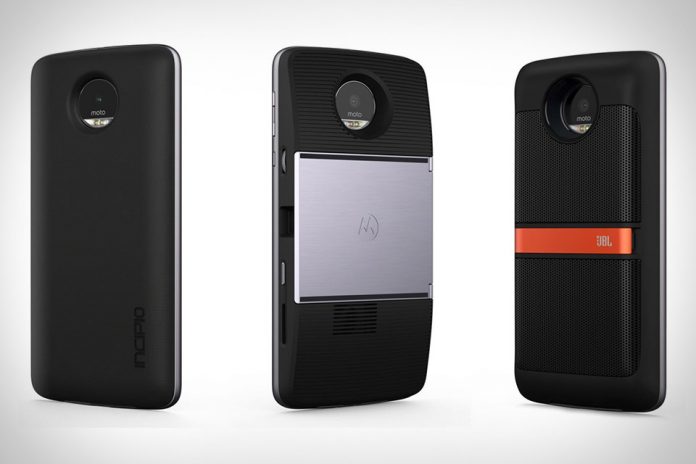
Motorola just announced their new modular concept smartphones, the Moto Z, and the Moto Z Force.
Modular smartphones are phones made using independent components that can be independently upgraded or replaced in a module design. The central part of these smartphones is the main board, to which other components adapt to, hence the term modular. Some of these elements include cameras, batteries, projectors, speakers, etc.
Modular smartphones concept has been out for some time now, but there wasn’t smartphone standing out in this area. Motorola new modular smartphones have been designed and built on what looks like a very stable modular platform. The Moto Z-Droid and Moto Z Force Droid are premium Android devices built on Qualcomm’s Snapdragon 820 platforms.
What stands out these smartphones to be prominent is the Lenovo-Motorola patented attachment system on the rear of the device along with their sleek, super-thin premium design.
Moto Z-Droid and Moto Z Force Droid’s back side consists of a highly polished metallic surface with a series of copper contact pins, through these pins Motorola’s mods can connect to the cell phone.
Motorola’s mods are magnetized, and they create a strong bond to the phone’s back
One of the big surprises Motorola is introducing is that attaching a Motorola mod doesn’t require rebooting the phone. Also, the mod functionality will be available for use immediately after plugging it in. Also, the Moto Z-Droid will tell you about the mod capabilities with some screen prompts.
Motorola’s Mod includes the $79 JBL Sound Boost speaker mod, A 6-watt powered speaker attachment. This mod adds a 1000 mAh battery that promises about to 10 hours of audio playback when combined with the phone’s battery. This is probably the best smartphone speaker out there for the time being regarding audio fidelity and volume.
As for the best mod, the $299 Moto Instant-Share Projecto Moto mod stands out as the best by far. Although it has a high price tag, once you attach it to the main platform it will start projecting the phone’s display out over the projector in a matter of seconds. It’s also a rather simple mod to use, and it only has two controls, a power button, and a focus wheel.
Last but not least, there’s the 59$ Incipio Offgrid Power Pack that will offer another 2220 mAh battery to the phone as soon as it is attached to the central platform. This mod has wireless charging capabilities by itself, and it also features an efficiency mode where it will only charge the phone if it falls below 80% battery.
Both the Moto Z-Droid and the Moto Z Force Droid are described as premium smartphones, and as for their performances, it is described as top class.
The Moto Z-Droid is built mostly of metal and glass. It is hard to find a smartphone that feels more solid than this one. The front is a single sheet of 2.5D Gorilla Glass that has five interruptions, one for the speaker near the top of the phone; One for the selfie LED flash next to it; The following for the static home button; And last two for small openings near the phone’s bottom where the microphones are.
The Motorola includes the new Moto ShatterShield, which is a five-layer system that it is said to resist shattering even when dropped. The ShatterShield features an exterior glass layer with what Motorola called a “proprietary hard coat designed to guard against dents and abrasion,”
Regarding their cameras, the Moto Z-Droid features a 13MP with OIS while the Moto Z Force Droid uses a 21MP with OIS camera along with a Motorola’s camera app which is pretty simple to use.
It also has a more complex mode called “Professional mode” that gives the user complete power over settings like shutter speed, white balance, ISO and focus. The camera app also has the Motorola’s “Best Shot” feature, which snaps several shots with each tap of the shutter button and allows you the pick the best ones.
Cameras in both Moto Z-Droid and Moto Z Force Droid can capture explicit photos with careful color reproduction, also videos are very stable thanks to the OIS and fast Autofocus.
Finally, Motorola decided to remove the 3.5mm headphone jack just like Apple did to make more space for other components. Even so, you will be able to use the headphones with a USB-C to 3.5mm audio adapter, or you can also use Bluetooth Headphones.
Verizon Customers will be able to pre-order the Moto Z-Droid and Moto Z Force Droid on Verizon’s website immediately ahead of the phone’s release next Thursday, July 28th. The Moto Z-Droid starts at $26 per month or $624 outright, while the Moto Z Force Droid starts at $30 per month or $720.
Source: Hot Hardware










